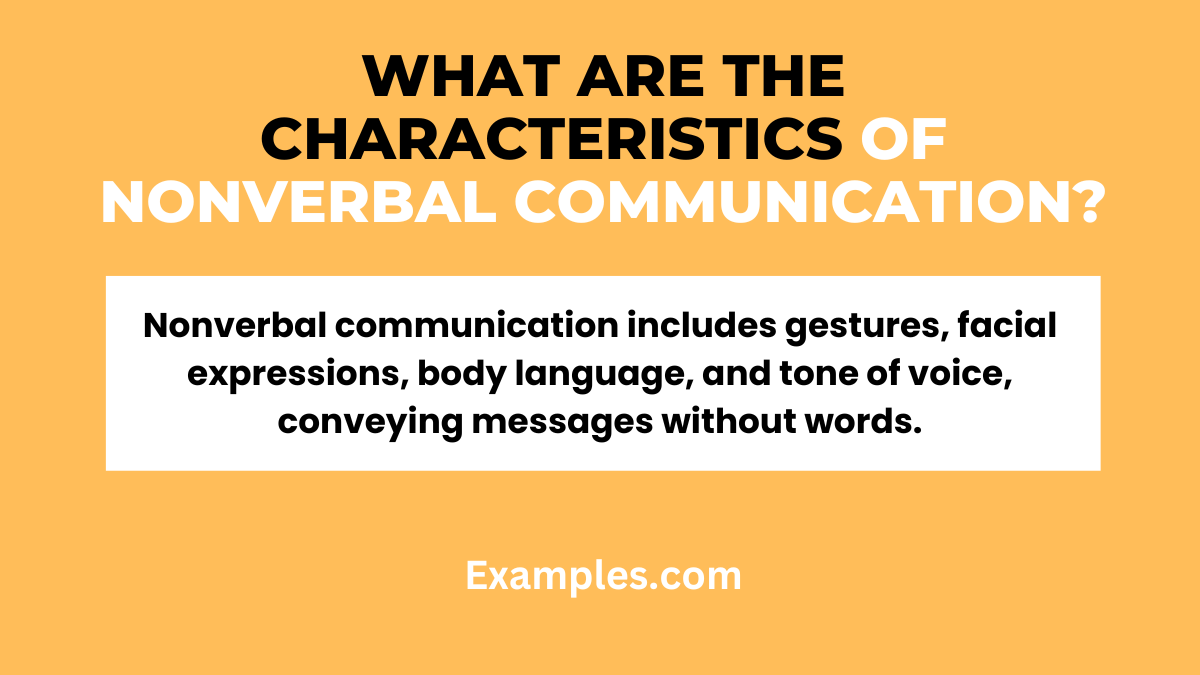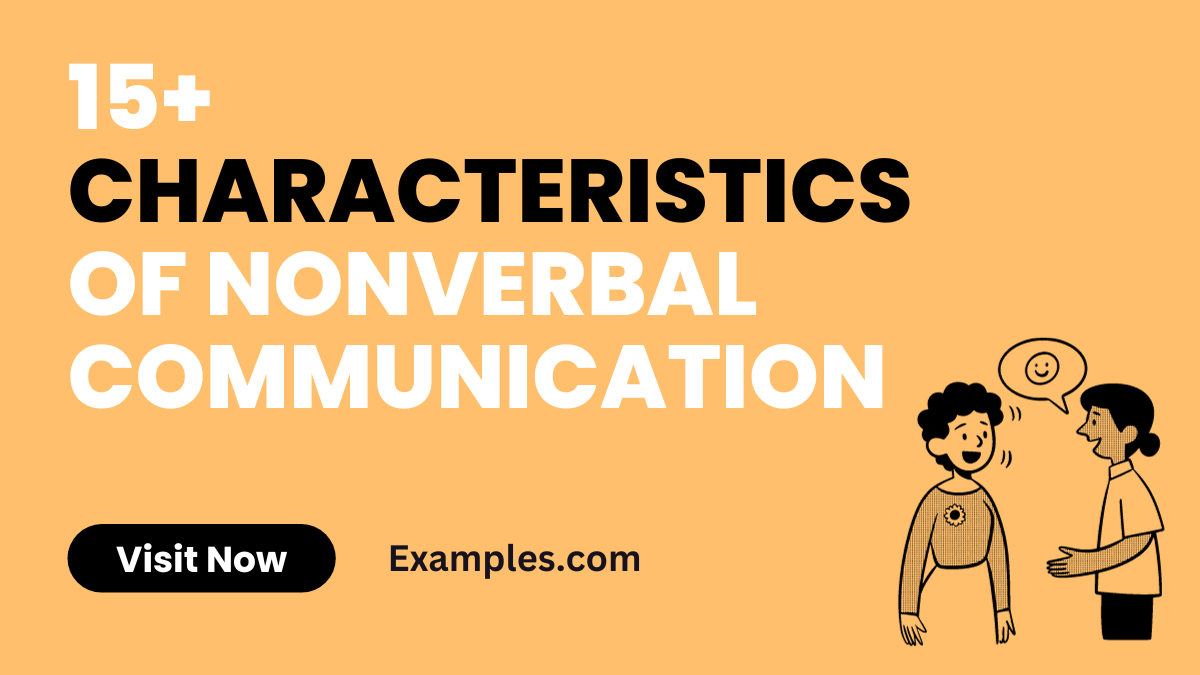14+ Characteristics of Nonverbal Communication Examples
Understanding the Characteristics of Nonverbal Communication unveils a world beyond words. This complete guide explores the silent yet powerful realm where actions speak louder than words. Delve into how Facial Expressions in Nonverbal Communication and Body Language in Nonverbal Communication play pivotal roles in conveying emotions and intentions. These characteristics form the unspoken backbone of human interactions, offering insights into the subtleties of nonverbal cues and their impact on everyday communication.
What are the Characteristics of Nonverbal Communication? – Definition

Nonverbal communication encompasses all forms of communication that occur without the use of words. It includes various elements like body language, facial expressions, gestures, and eye contact. These components convey emotions and intentions often more powerfully than verbal means. Nonverbal cues can complement, contradict, or substitute verbal messages, playing a crucial role in interpersonal interactions. Understanding these cues is essential as they often reveal more than spoken words, providing depth and context to communication.
15 Characteristics of Nonverbal Communication

Nonverbal communication, encompassing a vast array of human interactions beyond words, plays a crucial role in conveying emotions and intentions. This article explores 30 key characteristics of nonverbal communication, offering a deep dive into the silent yet impactful world of unspoken cues. Each characteristic is elaborated with examples, making it insightful for both personal and professional growth.
Facial Expressions in Nonverbal Communication

Facial expressions are a crucial component of nonverbal communication, involving the movement of facial muscles to convey emotions and reactions. They are universal across cultures, often conveying emotions such as happiness, sadness, anger, surprise, fear, and disgust. Facial expressions can complement verbal communication, contradict it, or stand alone as a form of silent communication.
Example: A smile typically signifies happiness or friendliness, while a frown often indicates sadness or disapproval. During a job interview, a candidate’s nervousness might be betrayed by a forced smile, despite verbally expressing confidence.
Body Language in Nonverbal Communication

Body language, an integral part of nonverbal communication, encompasses posture, stance, and physical movements to express emotions and attitudes. It’s a powerful tool for conveying feelings and intentions without words, often revealing more than verbal communication. Body language can align with or contradict spoken words, adding depth to interpersonal interactions.
Example: Crossing arms may indicate defensiveness or discomfort, while an open stance could suggest confidence and openness. In a negotiation, a relaxed posture with open hands may signal a willingness to cooperate.
Gestures in Nonverbal Communication

Gestures are movements of the hands, arms, or head that serve as a nonverbal means to communicate. They can emphasize points in conversation, illustrate ideas, or convey emotions and attitudes. Gestures vary across cultures, making them an essential aspect of effective cross-cultural communication.
Example: Nodding often signifies agreement or understanding, while pointing can be used to direct attention. In a classroom, a teacher might use hand gestures to emphasize key points, aiding in student comprehension.
Eye Contact in Nonverbal Communication

Eye contact is a significant aspect of nonverbal communication, reflecting a range of emotions and intentions. It can signal interest, attention, confidence, respect, or intimidation. Maintaining appropriate eye contact enhances communication effectiveness, while avoiding eye contact can convey disinterest, discomfort, or dishonesty.
Example: Consistent eye contact during a conversation signals engagement and sincerity, while frequent avoidance of eye contact might indicate distraction or unease. In a therapy session, a therapist’s steady eye contact can establish trust and attentiveness.
Touch (Haptics)

Touch, or haptics, is a pivotal aspect of nonverbal communication, conveying a range of emotions and messages through physical contact. It varies greatly across different cultures and contexts, influencing social interactions and relationships. The nature of touch can signal affection, aggression, comfort, or support, playing a crucial role in human bonding and communication.
Example: In a therapeutic setting, a gentle hand on a patient’s shoulder can convey empathy and reassurance, demonstrating nonverbal support and understanding without the need for words.
Space (Proxemics)

Space, or proxemics, refers to how people use physical space to communicate nonverbally. It encompasses personal space, territoriality, and the spatial relationships we maintain in various social and professional contexts. Proxemics can indicate intimacy, aggression, dominance, or affection, and varies greatly across cultures.
Example: In a business meeting, the distance maintained between colleagues around a table can indicate their level of comfort and status within the group, with closer proximity often signifying greater familiarity or assertiveness.
Physical Appearance

Physical appearance in nonverbal communication includes elements like clothing, grooming, and overall presentation. It sends powerful messages about one’s personality, social status, and even beliefs. First impressions are largely influenced by physical appearance, making it a critical component of nonverbal communication.
Example: In a job interview, a candidate’s formal attire and well-groomed appearance can convey professionalism and respect for the company’s culture, impacting the interviewer’s perception even before any conversation begins.
Paralanguage (Vocalics)

Paralanguage, or vocalics, involves the non-word aspects of verbal communication. It includes tone of voice, pitch, volume, and speech rate. Paralanguage can significantly alter the meaning of words, conveying emotions and attitudes that may not be explicit in the spoken words themselves.
Example: In customer service, a representative’s warm tone and calm speech can convey friendliness and assurance, fostering a positive interaction even if the spoken words are routine.
Adaptors in Nonverbal Communication

Adaptors are subconscious behaviors used to manage emotions or stress. They are a form of body language in nonverbal communication and can include habits like nail-biting or hair-twisting. These gestures often occur without the individual’s awareness but can convey feelings of nervousness or discomfort to observers.
Example: During a tense meeting, a person might repeatedly tap their foot or fidget with a pen. These actions, often subconscious, signal their anxiety or impatience, providing cues about their emotional state to others.
Sign Language in Nonverbal Communication

Sign language is a sophisticated system of hand gestures, facial expressions, and body postures used for communication, predominantly by the deaf and hard-of-hearing community. It’s a key type of nonverbal communication, encompassing a variety of languages and dialects worldwide, each with its own rules and syntax.
Example: In American Sign Language (ASL), conveying the concept of “happy” involves an open hand brushing in an upward motion along the chest, coupled with a smiling facial expression, effectively communicating the emotion without spoken words.
Time (Chronemics) in Nonverbal Communication

Chronemics, or the study of how time affects communication, is a crucial aspect of nonverbal communication. It includes punctuality, the amount of time spent in interactions, and the perception of time in conversations. Time usage can convey respect, priority, and cultural values.
Example: In professional settings, being punctual for meetings is often interpreted as a sign of respect and seriousness. Conversely, habitual tardiness might communicate disinterest or disrespect, impacting interpersonal dynamics.
Silence in Nonverbal Communication

Silence, a powerful element of nonverbal communication, can convey a multitude of messages without words. It can be used strategically to emphasize points, create emphasis, or express emotions like anger, agreement, or contemplation. The interpretation of silence varies greatly across different cultures.
Example: In a heated debate, one participant might choose to remain silent instead of responding immediately. This silence can be interpreted as a form of disagreement or a method of controlling the conversation’s tempo, allowing for cooling down of tempers.
Importance of Nonverbal Communication

Nonverbal communication is crucial as it conveys much of our message and emotions without words. It includes facial expressions, body language, gestures, eye contact, and more, making up a large part of our daily communication. Nonverbal cues often reveal true feelings and intentions, supplementing or contradicting spoken words, thereby enhancing understanding in interactions.
Example: A person’s crossed arms and frown while saying they’re open to feedback can indicate they’re actually defensive or upset.
Replying to Nonverbal Cues

Responding appropriately to nonverbal cues is essential in effective communication. It involves interpreting body language, facial expressions, and other nonverbal signals accurately and adjusting responses accordingly. This skill improves empathy and understanding, fostering better personal and professional relationships.
Example: Noticing a colleague’s slumped posture and downcast eyes, you might offer support or inquire about their well-being, showing empathy.
Principles of Nonverbal Communication

Nonverbal communication is governed by several principles. It is often unconscious but conveys powerful messages. These principles include congruency with verbal messages, cultural variations, context relevance, and the ability to complement, contradict, or substitute verbal communication. Understanding these principles helps in accurately interpreting and effectively using nonverbal cues.
Example: A firm handshake combined with direct eye contact at a job interview can convey confidence, complementing verbal expressions of competence.
For those seeking a deeper understanding of the characteristics of nonverbal communication, the following external links are highly recommended. The American Psychological Association offers extensive insights into various aspects of nonverbal communication, accessible at their official site APA. Additionally, Stanford University provides valuable educational resources and research findings related to nonverbal communication dynamics, which can be found at Stanford University. For a more focused approach on the cultural aspects and implications of nonverbal communication, the United Nations Educational, Scientific and Cultural Organization (UNESCO) offers relevant articles and studies at UNESCO. Each of these links is selected for their high domain authority and relevance to the topic, ensuring that readers can access high-quality, authoritative content.



